Elizabeth J. Cross
Active learning for regression in engineering populations: A risk-informed approach
Sep 06, 2024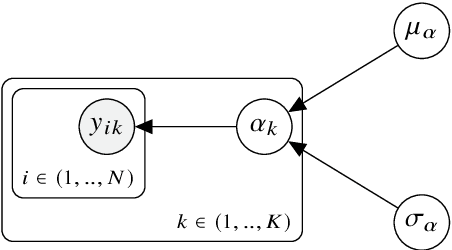



Abstract:Regression is a fundamental prediction task common in data-centric engineering applications that involves learning mappings between continuous variables. In many engineering applications (e.g.\ structural health monitoring), feature-label pairs used to learn such mappings are of limited availability which hinders the effectiveness of traditional supervised machine learning approaches. The current paper proposes a methodology for overcoming the issue of data scarcity by combining active learning with hierarchical Bayesian modelling. Active learning is an approach for preferentially acquiring feature-label pairs in a resource-efficient manner. In particular, the current work adopts a risk-informed approach that leverages contextual information associated with regression-based engineering decision-making tasks (e.g.\ inspection and maintenance). Hierarchical Bayesian modelling allow multiple related regression tasks to be learned over a population, capturing local and global effects. The information sharing facilitated by this modelling approach means that information acquired for one engineering system can improve predictive performance across the population. The proposed methodology is demonstrated using an experimental case study. Specifically, multiple regressions are performed over a population of machining tools, where the quantity of interest is the surface roughness of the workpieces. An inspection and maintenance decision process is defined using these regression tasks which is in turn used to construct the active-learning algorithm. The novel methodology proposed is benchmarked against an uninformed approach to label acquisition and independent modelling of the regression tasks. It is shown that the proposed approach has superior performance in terms of expected cost -- maintaining predictive performance while reducing the number of inspections required.
Sharing Information Between Machine Tools to Improve Surface Finish Forecasting
Oct 09, 2023Abstract:At present, most surface-quality prediction methods can only perform single-task prediction which results in under-utilised datasets, repetitive work and increased experimental costs. To counter this, the authors propose a Bayesian hierarchical model to predict surface-roughness measurements for a turning machining process. The hierarchical model is compared to multiple independent Bayesian linear regression models to showcase the benefits of partial pooling in a machining setting with respect to prediction accuracy and uncertainty quantification.
Encoding Domain Expertise into Multilevel Models for Source Location
May 15, 2023Abstract:Data from populations of systems are prevalent in many industrial applications. Machines and infrastructure are increasingly instrumented with sensing systems, emitting streams of telemetry data with complex interdependencies. In practice, data-centric monitoring procedures tend to consider these assets (and respective models) as distinct -- operating in isolation and associated with independent data. In contrast, this work captures the statistical correlations and interdependencies between models of a group of systems. Utilising a Bayesian multilevel approach, the value of data can be extended, since the population can be considered as a whole, rather than constituent parts. Most interestingly, domain expertise and knowledge of the underlying physics can be encoded in the model at the system, subgroup, or population level. We present an example of acoustic emission (time-of-arrival) mapping for source location, to illustrate how multilevel models naturally lend themselves to representing aggregate systems in engineering. In particular, we focus on constraining the combined models with domain knowledge to enhance transfer learning and enable further insights at the population level.
Canonical-Correlation-Based Fast Feature Selection
Jun 15, 2021



Abstract:This paper proposes a canonical-correlation-based filter method for feature selection. The sum of squared canonical correlation coefficients is adopted as the feature ranking criterion. The proposed method boosts the computational speed of the ranking criterion in greedy search. The supporting theorems developed for the feature selection method are fundamental to the understanding of the canonical correlation analysis. In empirical studies, a synthetic dataset is used to demonstrate the speed advantage of the proposed method, and eight real datasets are applied to show the effectiveness of the proposed feature ranking criterion in both classification and regression. The results show that the proposed method is considerably faster than the definition-based method, and the proposed ranking criterion is competitive compared with the seven mutual-information-based criteria.
Probabilistic Inference for Structural Health Monitoring: New Modes of Learning from Data
Mar 02, 2021
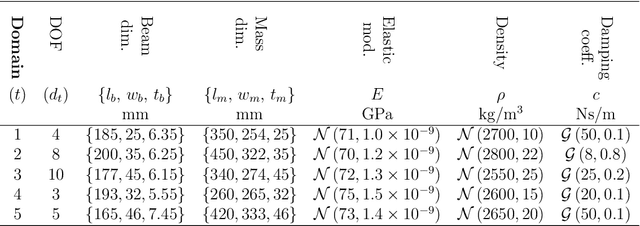
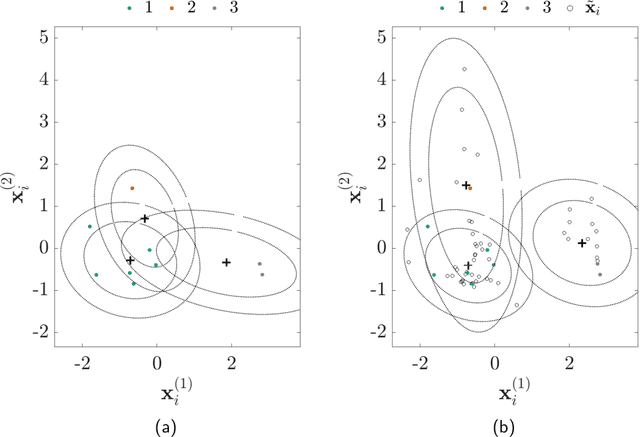

Abstract:In data-driven SHM, the signals recorded from systems in operation can be noisy and incomplete. Data corresponding to each of the operational, environmental, and damage states are rarely available a priori; furthermore, labelling to describe the measurements is often unavailable. In consequence, the algorithms used to implement SHM should be robust and adaptive, while accommodating for missing information in the training-data -- such that new information can be included if it becomes available. By reviewing novel techniques for statistical learning (introduced in previous work), it is argued that probabilistic algorithms offer a natural solution to the modelling of SHM data in practice. In three case-studies, probabilistic methods are adapted for applications to SHM signals -- including semi-supervised learning, active learning, and multi-task learning.
* This material may be downloaded for personal use only. Any other use requires prior permission of the American Society of Civil Engineers. This material may be found at https://doi.org/10.1061/AJRUA6.0001106
Damage detection in operational wind turbine blades using a new approach based on machine learning
Jan 25, 2021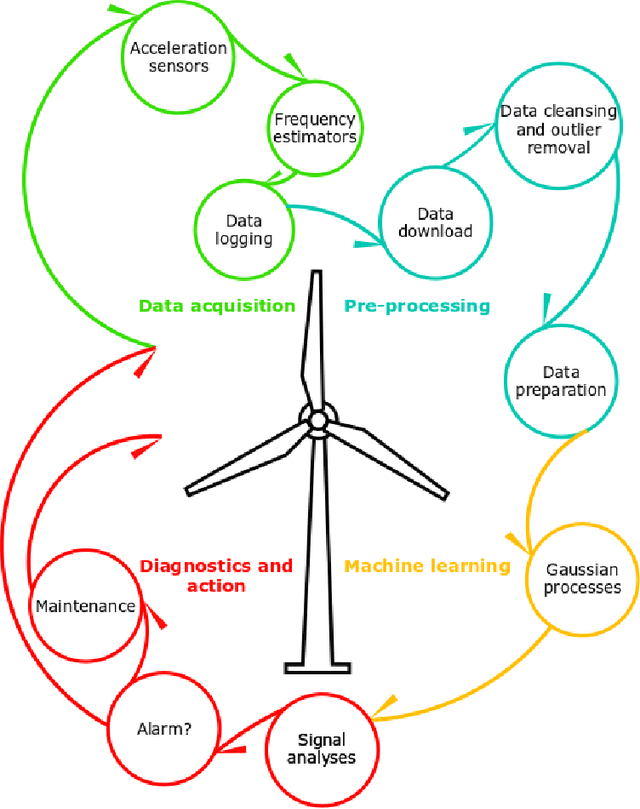
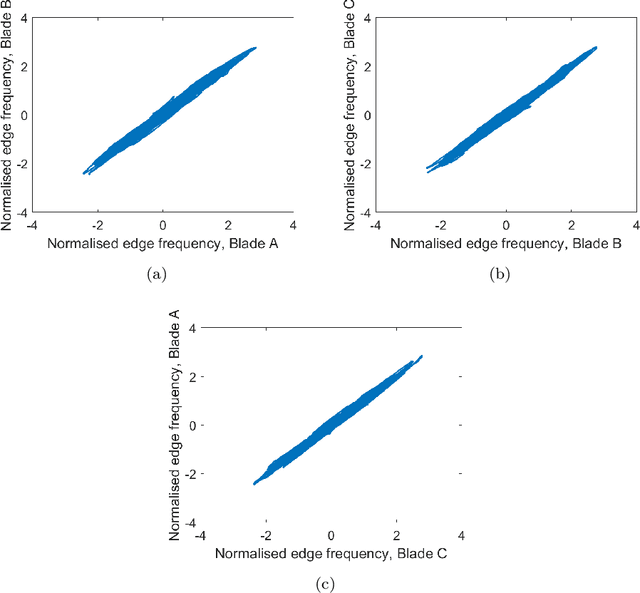

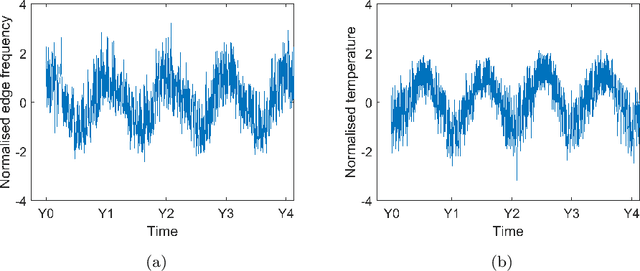
Abstract:The application of reliable structural health monitoring (SHM) technologies to operational wind turbine blades is a challenging task, due to the uncertain nature of the environments they operate in. In this paper, a novel SHM methodology, which uses Gaussian Processes (GPs) is proposed. The methodology takes advantage of the fact that the blades on a turbine are nominally identical in structural properties and encounter the same environmental and operational variables (EOVs). The properties of interest are the first edgewise frequencies of the blades. The GPs are used to predict the edge frequencies of one blade given that of another, after these relationships between the pairs of blades have been learned when the blades are in a healthy state. In using this approach, the proposed SHM methodology is able to identify when the blades start behaving differently from one another over time. To validate the concept, the proposed SHM system is applied to real onshore wind turbine blade data, where some form of damage was known to have taken place. X-bar control chart analysis of the residual errors between the GP predictions and actual frequencies show that the system successfully identified early onset of damage as early as six months before it was identified and remedied.
Structured Machine Learning Tools for Modelling Characteristics of Guided Waves
Jan 05, 2021



Abstract:The use of ultrasonic guided waves to probe the materials/structures for damage continues to increase in popularity for non-destructive evaluation (NDE) and structural health monitoring (SHM). The use of high-frequency waves such as these offers an advantage over low-frequency methods from their ability to detect damage on a smaller scale. However, in order to assess damage in a structure, and implement any NDE or SHM tool, knowledge of the behaviour of a guided wave throughout the material/structure is important (especially when designing sensor placement for SHM systems). Determining this behaviour is extremely diffcult in complex materials, such as fibre-matrix composites, where unique phenomena such as continuous mode conversion takes place. This paper introduces a novel method for modelling the feature-space of guided waves in a composite material. This technique is based on a data-driven model, where prior physical knowledge can be used to create structured machine learning tools; where constraints are applied to provide said structure. The method shown makes use of Gaussian processes, a full Bayesian analysis tool, and in this paper it is shown how physical knowledge of the guided waves can be utilised in modelling using an ML tool. This paper shows that through careful consideration when applying machine learning techniques, more robust models can be generated which offer advantages such as extrapolation ability and physical interpretation.
A Bayesian methodology for localising acoustic emission sources in complex structures
Dec 21, 2020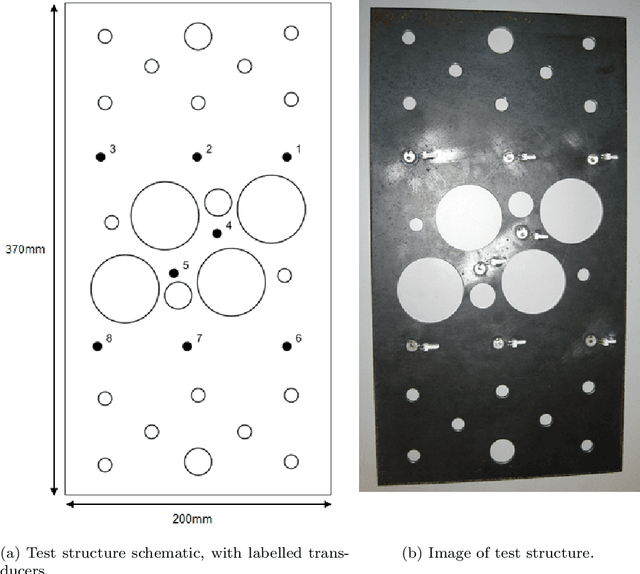
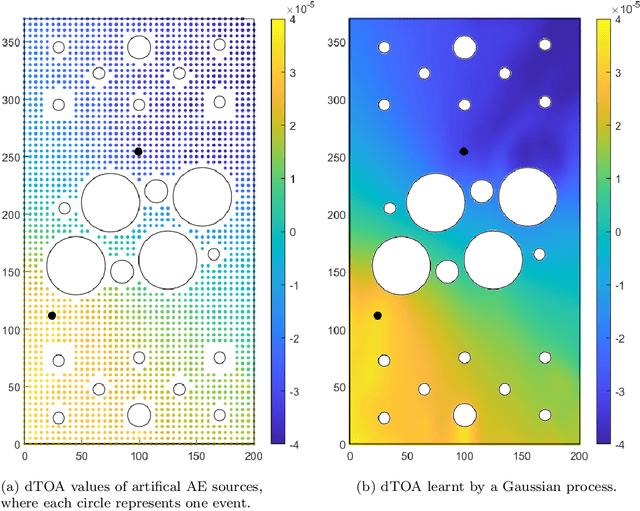
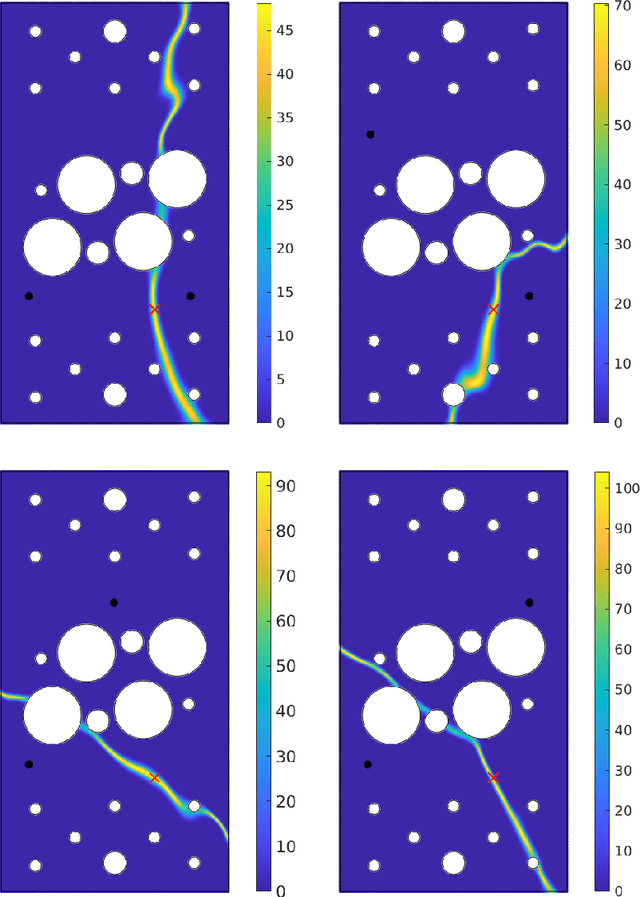

Abstract:In the field of structural health monitoring (SHM), the acquisition of acoustic emissions to localise damage sources has emerged as a popular approach. Despite recent advances, the task of locating damage within composite materials and structures that contain non-trivial geometrical features, still poses a significant challenge. Within this paper, a Bayesian source localisation strategy that is robust to these complexities is presented. Under this new framework, a Gaussian process is first used to learn the relationship between source locations and the corresponding difference-in-time-of-arrival values for a number of sensor pairings. As an acoustic emission event with an unknown origin is observed, a mapping is then generated that quantifies the likelihood of the emission location across the surface of the structure. The new probabilistic mapping offers multiple benefits, leading to a localisation strategy that is more informative than deterministic predictions or single-point estimates with an associated confidence bound. The performance of the approach is investigated on a structure with numerous complex geometrical features and demonstrates a favourable performance in comparison to other similar localisation methods.
 Add to Chrome
Add to Chrome Add to Firefox
Add to Firefox Add to Edge
Add to Edge